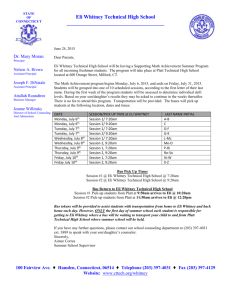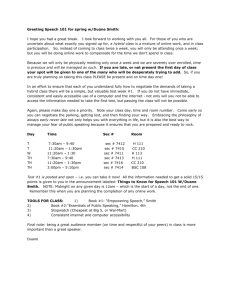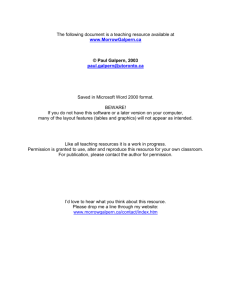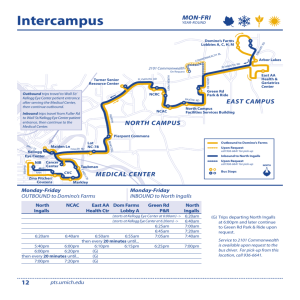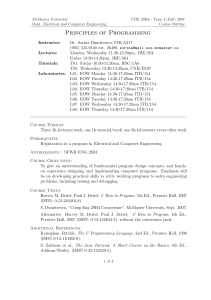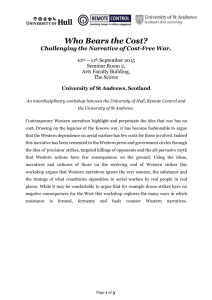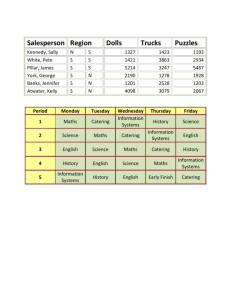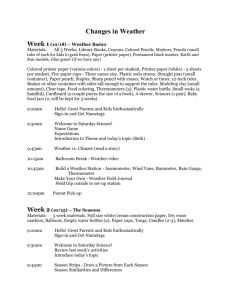EE136_GreenSheet - San Jose State University
advertisement
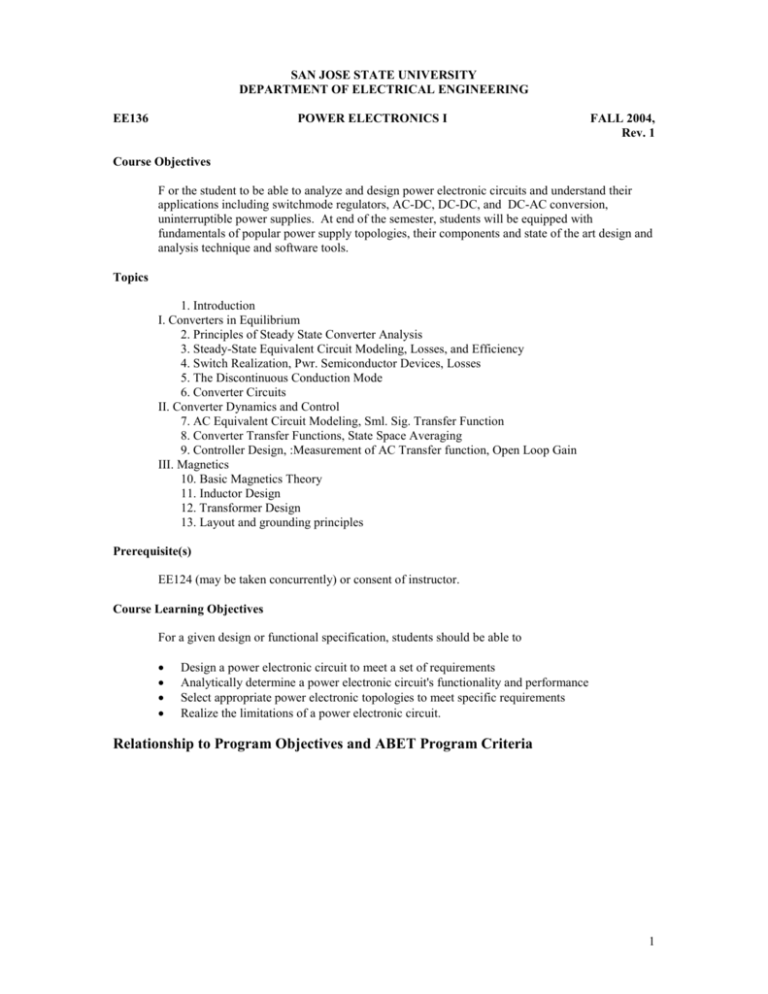
SAN JOSE STATE UNIVERSITY DEPARTMENT OF ELECTRICAL ENGINEERING EE136 POWER ELECTRONICS I FALL 2004, Rev. 1 Course Objectives F or the student to be able to analyze and design power electronic circuits and understand their applications including switchmode regulators, AC-DC, DC-DC, and DC-AC conversion, uninterruptible power supplies. At end of the semester, students will be equipped with fundamentals of popular power supply topologies, their components and state of the art design and analysis technique and software tools. Topics 1. Introduction I. Converters in Equilibrium 2. Principles of Steady State Converter Analysis 3. Steady-State Equivalent Circuit Modeling, Losses, and Efficiency 4. Switch Realization, Pwr. Semiconductor Devices, Losses 5. The Discontinuous Conduction Mode 6. Converter Circuits II. Converter Dynamics and Control 7. AC Equivalent Circuit Modeling, Sml. Sig. Transfer Function 8. Converter Transfer Functions, State Space Averaging 9. Controller Design, :Measurement of AC Transfer function, Open Loop Gain III. Magnetics 10. Basic Magnetics Theory 11. Inductor Design 12. Transformer Design 13. Layout and grounding principles Prerequisite(s) EE124 (may be taken concurrently) or consent of instructor. Course Learning Objectives For a given design or functional specification, students should be able to Design a power electronic circuit to meet a set of requirements Analytically determine a power electronic circuit's functionality and performance Select appropriate power electronic topologies to meet specific requirements Realize the limitations of a power electronic circuit. Relationship to Program Objectives and ABET Program Criteria 1 Outcome Assessment Program Objectives (3.a) an ability to apply knowledge of mathematics, science, and engineering (3.b) an ability to design and conduct experiments, as well as to analyze and interpret data (3.c) an ability to design a system, component, or process to meet desired needs Course Learning Objectives 1,2 Level of Support 3,4 Moderate 1,2,3,4 Advanced (3.d) an ability to function on multi-disciplinary teams (3.e) an ability to identify, formulate, and solve engineering problems Advanced NotSuported 1,2,3,4 Moderate (3.f) an understanding of professional and ethical responsibility NotSupported (3.g) an ability to communicate effectively NotSupported (3.h) the broad education necessary to understand the impact of engineering solutions in a global and societal context (3.i) a recognition of the need for, and an ability to engage in life-long learning (3.j) a knowledge of contemporary issues NotSupported (3.k) an ability to use the techniques, skills, and modern engineering tools necessary for engineering practice (3.l) one or more technical specialties that meet the needs of Silicon Valley companies NotSupported NotSupported 1-4 Advanced 1-4 Moderate Program Criteria knowledge of probability and statistics, including applications to electrical engineering knowledge of advanced mathematics, including differential and integral equations, linear algebra, complex variables, and discrete mathematics knowledge of basic sciences, computer science, and engineering sciences necessary to analyze and design complex electrical and electronic devices, software, and systems containing hardware and software components NotSupported 1,2,3,4 Moderate NotSupported Class participation Midterms and a final exam Student group projects , oral and written reports Semester-end course and instructor evaluation. Course Coordinator Peter Reischl, Ph.D. EE@SJSU Honesty and Respect for Others and Public Property EE HONOR CODE 2 The Electrical Engineering Department will enforce the following Honor Code that must be read and accepted by all students. “I have read the Honor Code and agree with its provisions. My continued enrollment in this course constitutes full acceptance of this code. I will NOT: Take an exam in place of someone else, or have someone take an exam in my place Give information or receive information from another person during an exam Use more reference material during an exam than is allowed by the instructor Obtain a copy of an exam prior to the time it is given Alter an exam after it has been graded and then return it to the instructor for re-grading Leave the exam room without returning the exam to the instructor.” Measures Dealing with Occurrences of Cheating Department policy mandates that the student or students involved in cheating will receive an “F” on that evaluation instrument (paper, exam, project, homework, etc.) and will be reported to the Department and the University. A student’s second offense in any course will result in a Department recommendation of suspension from the University. 3 EE136 POWER ELECTRONICS I FALL 2004, Rev. 1 Course Instructor Dongsheng Zhou, Ph.D. Office and Office Hours Lecture: ENGR 329; Time: MW 7:05-8:20am Office: ENGR 351 (Part Time Faulty Room); Time: MW 08:30-09:00am (after lecture) Web Site: http://www.engr.sjsu.edu/dzhou/EE136Web0804 E-mail 408-863-9966, dzhou1@email.sjsu.edu Textbook(s) and Other Required Material F undamentals of Power Electronics 2nd edition by Robert W. Erickson and Dragan Maksimovic, Kluwer Academic Publishers, 2002. Reference(s) 1. Power Electronics Lecture Handouts, available on class web site http://www.engr.sjsu.edu/dzhou/EE136Web0804 before lecture time. 2. Power Supply Cookbook, by Marty Brown, 2nd ed. EDN, 2001. 3. Principles of Power Electronics, by John G. Kassakian etc, Addison-Wesley, 1991. Project(s) and Homework Homework in class assignments are an extremely important part of this course and you should pay it the required amount of attention. They will be your principle method of learning the course. Worked solutions will not need to be handed in. Solutions will be posted. You are also required to hand in a formal written project report, typed, including abstract, table of contents, introduction, theory, implementation, pictures and experimental results (if any), conclusion, and a list of references. For details please see attached sheet. Exams T here will be 2 Midterm exams, 1 Final exam and multiple quiz. Exam problems will be based upon homework problems. Grading Midterm Exam1 Midterm Exam2 Quiz Class Project Final Exam 20 % 20 % 20% 20 % 20 % 4 EE136 POWER ELECTRONICS I FALL 2004 Course Schedule DATE TIME 8/25 7:05-8:20am Introduction to power electronics; Principles of steady-state converter analysis. Ch. 1 Ch. 2 8/30 9/01 9/6 9/8 7:05-8:20am 7:05-8:20am Ch. 2 Ch. 3 9/13 9/15 9/20 9/22 9/27 7:05-8:20am 7:05-8:20am 7:05-8:20am 7:05-8:20am 7:05-8:20am 9/29 10/04 10/06 10/11 10/13 10/18 7:05-8:20am 7:05-8:20am 7:05-8:20am 7:05-8:20am 7:05-8:20am 7:05-8:20am 10/20 7:05-8:20am 10/25 7:05-8:20am 10/27 11/1 7:05-8:20am 7:05-8:20am 11/3 11/8 7:05-8:20am 7:05-8:20am 11/10 11/15 7:05-8:20am 7:05-8:20am 11/17 7:05-8:20am 11/22 7:05-8:20am 11/24 7:05-8:20am 11/29 12/1 12/6 12/8 12/14 7:05-8:20am 7:05-8:20am 7:05-8:20am 7:05-8:20am 7:15-9:30am Principles of steady-state converter analysis. Equivalent circuit modeling. Labor Day, No class Equivalent circuit modeling of losses; Steady-state modeling examples, Semiconductor switches. Power semiconductor devices. Power semiconductor devices and switching loss. Power semiconductor devices and switching loss The discontinuous conduction mode. The discontinuous conduction mode; Converter topologies. Transformer-isolated converters. Transformer-isolated converters. Transformer-isolated converters. MIDTERM EXAM 1 Introduction to dynamic modeling of converters. Dynamic modeling of converters; State-space averaging. The canonical model; modeling the PWM; Review of Bode diagrams. Second-order responses; Converter small-signal transfer functions. Design-oriented analysis; Measurement of ac transfer functions; Intro to converter control systems. Control system analysis. Design example; Measurement of loop gains. MIDTERM EXAM 2 Review of basic magnetics; Inductors and transformers. Loss mechanisms; More about proximity losses. Types of magnetic devices and their design; Inductor design Multiple-winding inductors; Transformer design. Transformer design. Transformer design examples. Layout and grounding issues. Project presentation time. FINAL EXAM, where 329 7:05-8:20am TOPIC READING PROBLE MS Will be given on web site. Ch. 3 Ch. 4 Ch. 4 Ch. 4 Ch. 5 Ch. 5,6 Ch. 6 Ch. 6 Ch. 6 Ch. 7 Ch. 7 Ch. 7,8 Ch. 8 Ch. 8 Ch.8, 9 Ch. 9 Ch. 9 Ch. 13 Ch. 13 Ch. 13,14 Ch. 14,15 Ch. 15 Ch. 15 Notes 5 Discussion on EE136 project Fall 2004. Objective: Build a DC/DC switch mode power supply. Due Dates: 12/1 – 12/8 (due when you present in class) Results: 1. 2. Project report; Class demonstration of your power supply; Approach: 1. 2. You are required to select one power supply from following three applications. You will work alone, design, select component and build the power supply. a. A battery charger for one cell. Input voltage will be 5 to 5.5V. Output 2A max. b. A White light LED supply. Input voltage 3-5.5V. Output carries 4 LEDs. You will demonstrate that your power supply can: a. Regulate for the specified input voltage range and output load; b. Handle input voltage transient; c. Handle output short circuit and open circuit. Schedule: 1. 2. 3. 4. 10/01/03 – deadline for submitting your intended application. I intend to divide the students into two equal groups for above two applications.; 10/23/03 – Submit preliminary report on your chosen application. Content should include but not limit to: a. What is the application; b. What are the solutions? c. How are you going build the power supply? 11/3/03 – Return of your report by instructor with comments for final report and demonstration; 12/1/03 – Start class presentation (we may schedule a Saturday for demonstration). Hints to obtain good score on your project: 1. Do it early. Come to discuss with your instructor with your question. 2. Debug your circuit and make it work. General hints on getting a good score from EE136: 1. come to lectures; 2. do your homework and other assignment on time (any copying or late submission will be discounted); 3. study for your exams; 4. do your project early. 6

